Perceptual discrimination in static and dynamic noise: the temporal relation between perceptual encoding and decision making
- PMID: 20121313
- PMCID: PMC2854493
- DOI: 10.1037/a0018128
Perceptual discrimination in static and dynamic noise: the temporal relation between perceptual encoding and decision making
Abstract
The authors report 9 new experiments and reanalyze 3 published experiments that investigate factors affecting the time course of perceptual processing and its effects on subsequent decision making. Stimuli in letter-discrimination and brightness-discrimination tasks were degraded with static and dynamic noise. The onset and the time course of decision making were quantified by fitting the data with the diffusion model. Dynamic noise and, to a lesser extent, static noise, produced large shifts in the leading edge of the response-time distribution in letter discrimination but had little effect in brightness discrimination. The authors interpret these shifts as changes in the onset of decision making. The different pattern of shifts in letter discrimination and brightness discrimination implies that decision making in the 2 tasks was affected differently by noise. The changes in response-time distributions found with letter stimuli are inconsistent with the hypothesis that noise increases response times to letter stimuli simply by reducing the rate at which evidence accumulates in the decision process. Instead, they imply that noise also delays the time at which evidence accumulation begins. The delay is shown not to be the result of strategic processes or the result of using different stimuli in different tasks. The results imply, rather, that the onset of evidence accumulation in the decision process is time-locked to the perceptual encoding of the stimulus features needed to do the task. Two mechanisms that could produce this time-locking are described.
Figures


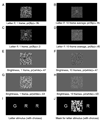
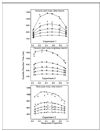
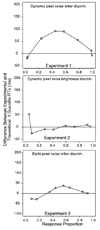

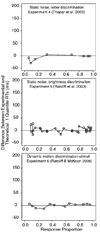

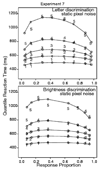


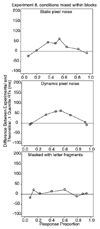

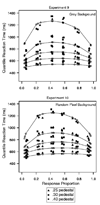

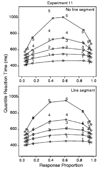
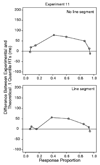




Similar articles
-
Attention orienting and the time course of perceptual decisions: response time distributions with masked and unmasked displays.Vision Res. 2004 Jun;44(12):1297-320. doi: 10.1016/j.visres.2004.01.002. Vision Res. 2004. PMID: 15066392
-
Neuronal adaptation effects in decision making.J Neurosci. 2011 Jan 5;31(1):234-46. doi: 10.1523/JNEUROSCI.2757-10.2011. J Neurosci. 2011. PMID: 21209209 Free PMC article.
-
Expectations Do Not Alter Early Sensory Processing during Perceptual Decision-Making.J Neurosci. 2018 Jun 13;38(24):5632-5648. doi: 10.1523/JNEUROSCI.3638-17.2018. Epub 2018 May 17. J Neurosci. 2018. PMID: 29773755 Free PMC article.
-
Perceptual learning: top to bottom.Vision Res. 2014 Jun;99:69-77. doi: 10.1016/j.visres.2013.11.006. Epub 2013 Dec 1. Vision Res. 2014. PMID: 24296314 Review.
-
An integrated theory of attention and decision making in visual signal detection.Psychol Rev. 2009 Apr;116(2):283-317. doi: 10.1037/a0015156. Psychol Rev. 2009. PMID: 19348543 Review.
Cited by
-
Scene complexity modulates degree of feedback activity during object detection in natural scenes.PLoS Comput Biol. 2018 Dec 31;14(12):e1006690. doi: 10.1371/journal.pcbi.1006690. eCollection 2018 Dec. PLoS Comput Biol. 2018. PMID: 30596644 Free PMC article.
-
Drifting through Basic Subprocesses of Reading: A Hierarchical Diffusion Model Analysis of Age Effects on Visual Word Recognition.Front Psychol. 2016 Nov 25;7:1863. doi: 10.3389/fpsyg.2016.01863. eCollection 2016. Front Psychol. 2016. PMID: 27933029 Free PMC article.
-
Modelling the impact of single vs. dual presentation on visual discrimination across resolutions.Q J Exp Psychol (Hove). 2025 Apr;78(4):827-841. doi: 10.1177/17470218241255670. Epub 2024 Jun 19. Q J Exp Psychol (Hove). 2025. PMID: 38714527 Free PMC article.
-
Modeling evidence accumulation decision processes using integral equations: Urgency-gating and collapsing boundaries.Psychol Rev. 2022 Mar;129(2):235-267. doi: 10.1037/rev0000301. Epub 2021 Aug 19. Psychol Rev. 2022. PMID: 34410765 Free PMC article.
-
Selection history influences an attentional decision bias toward singleton targets.Atten Percept Psychophys. 2023 Apr;85(3):825-833. doi: 10.3758/s13414-022-02627-8. Epub 2022 Dec 1. Atten Percept Psychophys. 2023. PMID: 36456797 Free PMC article.
References
-
- Busemeyer JR, Townsend JT. Fundamental derivations from decision field theory. Mathematical Social Sciences. 1992;23:255–282.
-
- Donders FC. On the speed of mental processes. In: Koster WG, translator; Koster WG, editor. Attention and Performance II. Amsterdam: North-Holland: 1969. pp. 412–431. (Original work published in Onderzoekingen Gedann in het Psycologisch Laboratorium der Utrechtsche Hoogeschool, Tweede reeks, 1868–1869, II, pp. 92–120.).
-
- Gould IC. Unpublished B.Sc. Honors thesis. The University of Melbourne; 2004. Attentional mechanisms in visual signal detection: Signal enhancement or uncertainty reduction.
-
- Gould IC, Wolfgang BJ, Smith PL. Spatial uncertainty explains endogenous and exogenous cuing effects in visual signal detection. Journal of Vision. 2007;7:1–17. - PubMed

